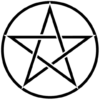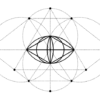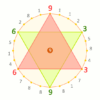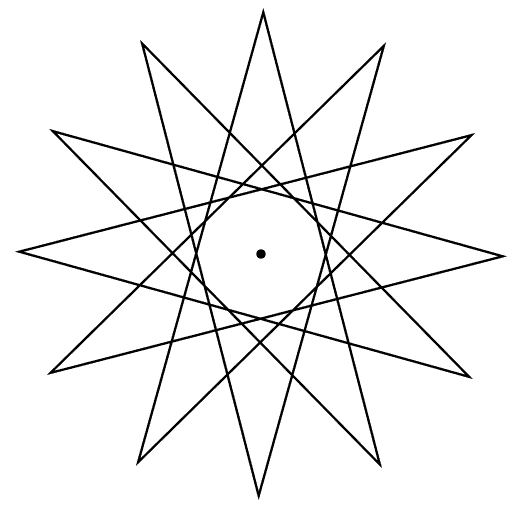
The 12-pointed star, also known as the Dodecagram, is an ancient symbol rich in meaning. It symbolizes creation, balance, harmony, the cyclical nature of life, positive energy, protection, and more.
In this article, let’s explore the diverse spiritual meanings associated with this star, along with the essential life lessons it embodies. Let’s start with the 4 different ways to draw the star.
4 Ways Draw the 12-Pointed Star (Dodecagram)
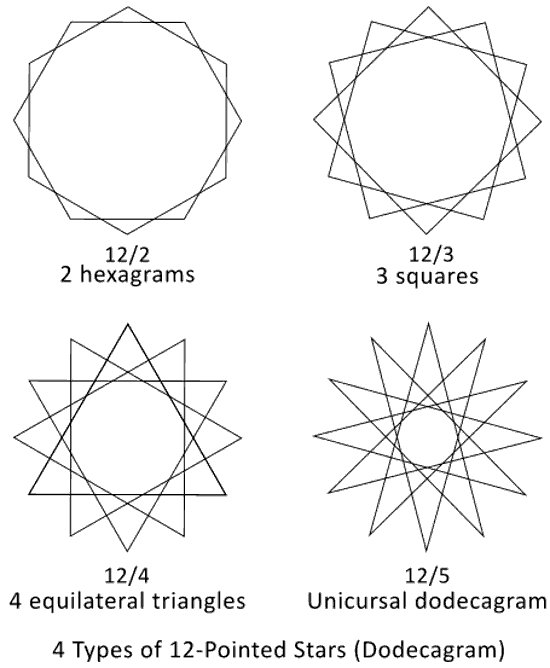
The 12-Pointed Star can be drawn in 4 different ways. They are as follows:
- 12/2 12-pointed star – comprises two hexagrams.
- 12/3 12-pointed star – comprises three squares.
- 12/4 12-pointed star – comprises four equilateral triangles.
- 12/5 or Unicursal 12-pointed star – Can be drawn in a single, unbroken stroke without lifting the pen.
To draw a 12/2 12-pointed star, you start with a 12-sided polygon, (also known as a dodecagon) and connect every second vertex until the first hexagon is completed. You can then link the remaining points to form the second hexagon, as shown below.
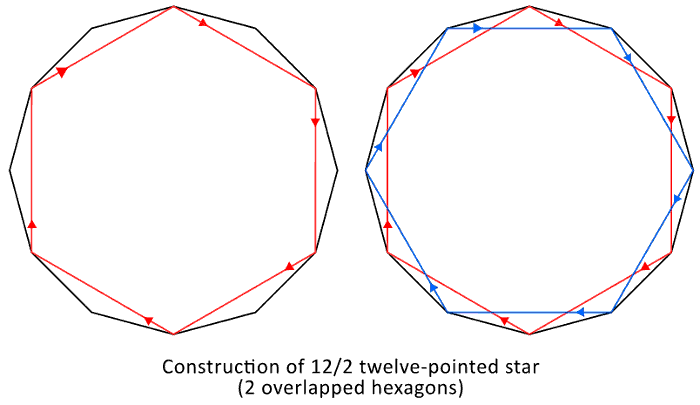
For the 12/3 12-pointed star, you connect every third vertex in the dodecagon. This creates the first square. Continue in this pattern to form the other two squares. See the example below.
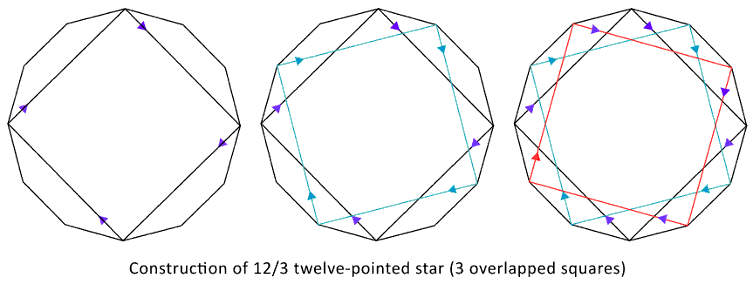
In constructing the 12/4 12-pointed star, you connect every fourth vertex in the dodecagon. This forms the first triangle. Continue in the same pattern to create a total of four triangles, as demonstrated below.
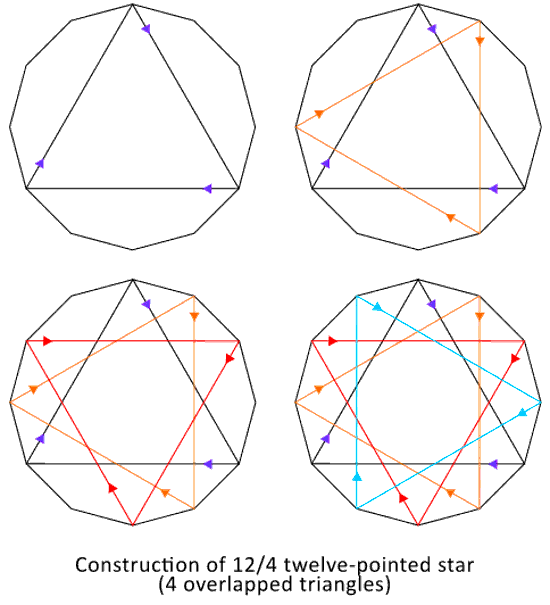
Lastly, to create a 12/5 12-pointed star or the Unicursal Dodecagram, connect every fifth vertex in the dodecagon until the star is complete. This star is unique because it can be drawn in one continuous stroke without lifting the pen.
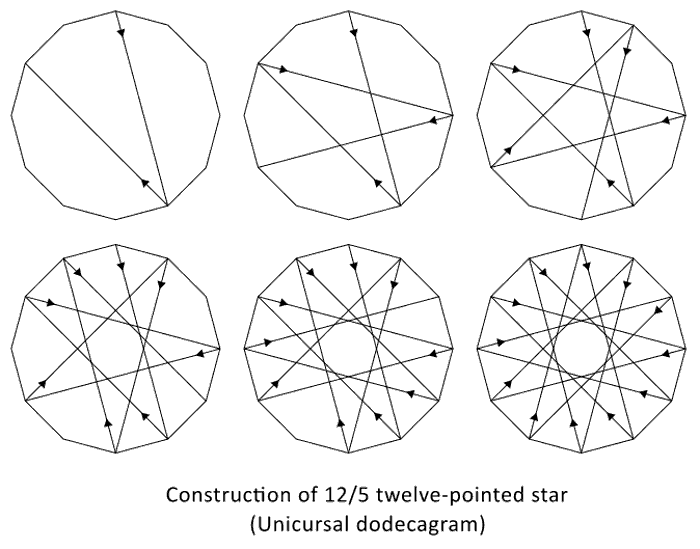
The image below illustrates all four types of 12-pointed stars combined.
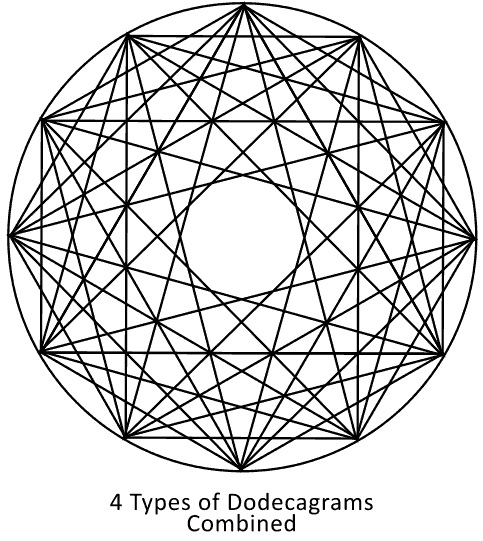
This symbol is special as it contains the circle, triangles, squares, rectangles, and hexagons in a single design!
12 Meanings Associated with the 12-Pointed Star (Dodecagram)
1. 12 Zodiac Signs Based on the 12 Constellations
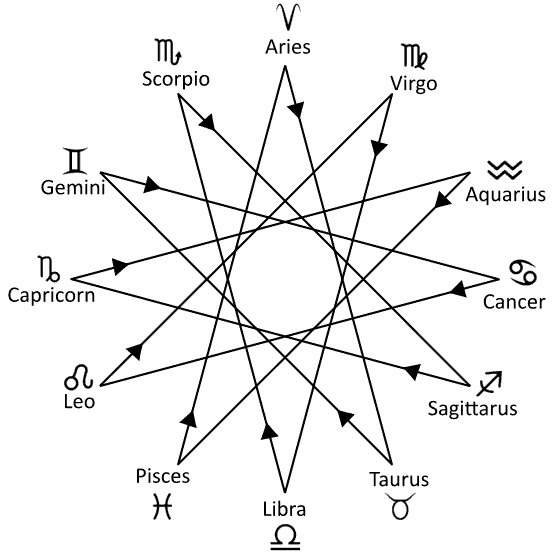
The 12-pointed star primarily represents the 12 Zodiac signs which are Aries, Taurus, Gemini, Cancer, Leo, Virgo, Libra, Scorpio, Sagittarius, Capricorn, Aquarius, and Pisces. Each sign is associated with distinctive personality traits, qualities, and meanings in astrology which are thought to be inherent in individuals born under them.
It’s interesting to note that these 12 Zodiac signs are based on the 12 constellations identified by ancient civilizations like the Babylonians.
What’s unique about these constellations is that they align with the Sun’s path across the sky, known as the ecliptic. As Earth orbits the Sun, it appears as if the Sun moves through these 12 constellations.
In astrology, the twelve zodiac signs are generally grouped into four elements: Fire, Earth, Air, and Water. Each of these elements is associated with three zodiac signs.
Here’s how they break down:
- Fire signs (Aries, Leo, Sagittarius) are passionate, dynamic, and can be impulsive.
- Earth signs (Taurus, Virgo, Capricorn) are practical, disciplined, and value stability.
- Air signs (Gemini, Libra, Aquarius) are intellectual, sociable, and open-minded.
- Water signs (Cancer, Scorpio, Pisces) are sensitive, intuitive, and deeply connected to emotions.
These can be represented using the 12/4 twelve-pointed star that consists of 4 interlocked triangles (as shown in the image below).
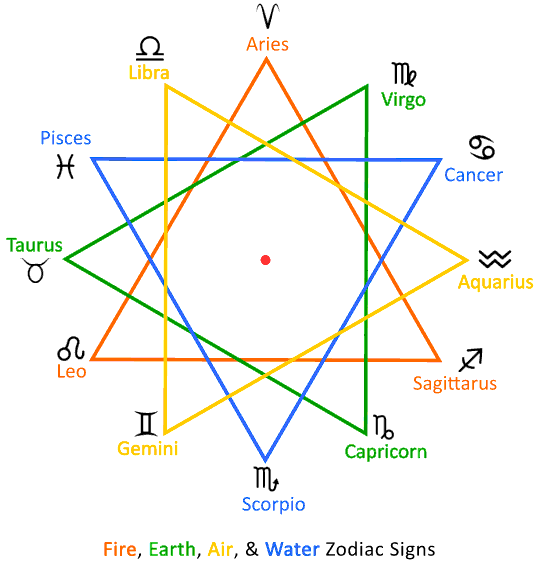
The 12 zodiac signs can also be divided into masculine and feminine signs.
The following six zodiac signs are considered masculine:
And these six signs are considered feminine:
These can be represented using the 12/2 twelve-pointed star consisting of 2 hexagrams as shown in the image below.
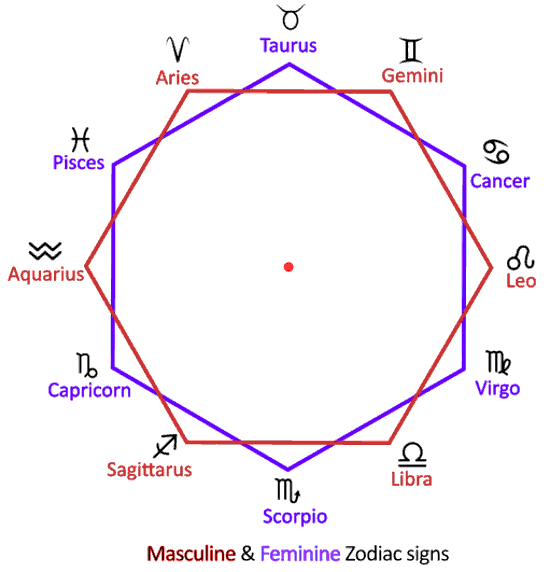
Now let’s look at the various other symbolisms associated with the 12-pointed star.
2. Twelve Months in a Year
The 12-pointed star symbolizes the 12 months of the year.
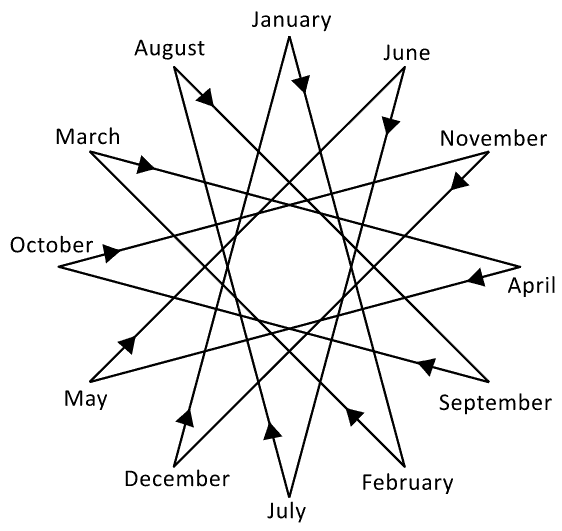
It’s interesting to note that the number 12 isn’t random. There’s a scientific reason why it was chosen to represent the months in a year.
The 12-month system originates from the lunar cycle, wherein the moon completes one full revolution around the earth, going through all its phases—Full Moon, Waning Moon, New Moon, Waxing Moon—in roughly 29.5 days.
Concurrently, the earth takes about 365 days to make one full revolution around the sun, which we define as one year. When you divide 365 by 29.5, the result closely approximates 12.
Hence, each complete revolution of the Earth around the sun incorporates approximately 12 lunar cycles. Similarly, as we saw earlier, the sun also seems to pass through 12 constellations over the course of a year.
Therefore, choosing 12 as the number of months in a year isn’t arbitrary—it’s profoundly ingrained in our celestial dynamics.
3. Completion, Wholeness, & Perfection

Much like the 9-pointed star, the 12-pointed star is also symbolically connected to completion, wholeness, and perfection. It represents the cyclical nature of the universe, which is mirrored in the earthly constructs of time.
For instance, as we saw earlier, there are 12 months in a year corresponding to the sun’s passage through exactly 12 constellations. Similarly, a clock face displays 12 hours, reinforcing the recurring pattern of 12 in our daily life.
4. Balance, Harmony, Unity, & Interconnection
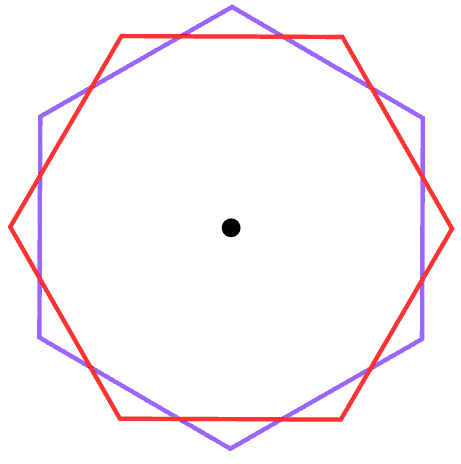
The 12-pointed star when represented in the form of 2 overlapping hexagons becomes a potent symbol of balance and harmony. The overlapped hexagrams represent the interconnectedness of physical and spiritual, heaven and earth, or any two opposing but complementary aspects of existence.
It also symbolizes the balance between opposing forces or dualities, much like the Yin and Yang concept in Chinese philosophy.

Similarly, the Unicursal Dodecagram (as shown in the image above) is also a symbol of unity, balance, interdependence, interconnection, and the cyclic nature of existence as it can be drawn with a single stroke without lifting the pen.
5. Protection & Good Energy
Historically, the hexagram or six-pointed star has been a powerful symbol of protection. In medieval Jewish culture, for example, it was used as an amulet to ward off evil spirits and negative energies. Legend has it that King David used this symbol on his shield to achieve protection and victory in battle.
Thus, the 12-pointed star, designed as a double-hexagram, is seen as a symbol of enhanced or double protection.
6. Cyclic Nature of Existence
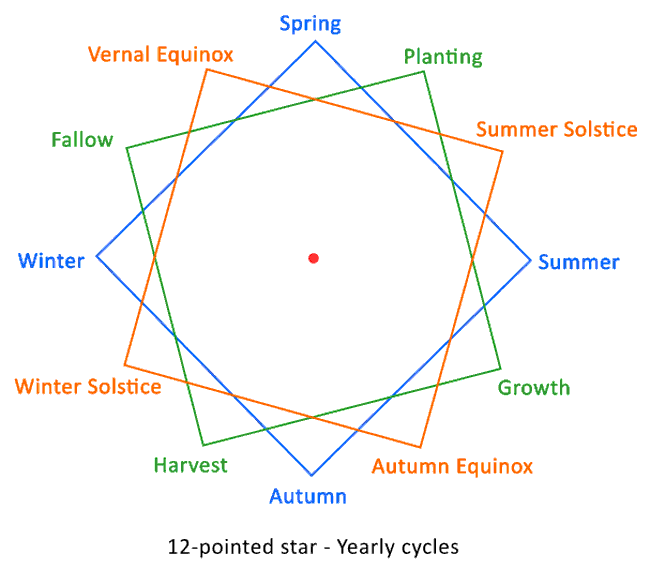
In addition to denoting the 12-month year and the 12-hour clock, the 12/3 12-pointed star also represents the 3 major cycles that occur within a year:
- 2 Equinoxes and 2 Solstices: The two Equinoxes (Vernal and Autumn Equinox) and the two Solstice (Summer and Winter Solstice) are yearly events that represent the changing of seasons due to the Earth’s tilt and orbit around the sun.
- Four Seasons: The four major seasons are spring, summer, autumn, and winter.
- 4 Agricultural seasons: In traditional farming societies the four agricultural seasons include, Planting, Growth, Harvest, and Fallow.
Thus, the 12-point star represents the cyclical nature of existence and the interconnectedness of various aspects of life and the universe. It reflects the balance and harmony of the cosmos.
7. Fundamental Nature of Physical Reality
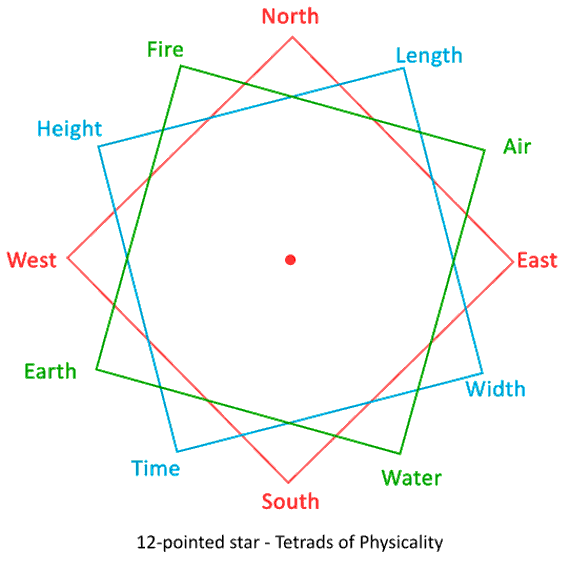
The 12/3 12-pointed star (consisting of 3 squares) can also be used to represent the four basic aspects of physical reality as follows. Squares as such also represent physicality and the material universe.
- Four Directions: North, South, East, and West, representing spatial orientation.
- Four Elements: Earth, Air, Fire, and Water, which are the basis of physical reality.
- Four Dimensions: The three dimensions of space (length, width, and height) and one dimension of time, that constitute the material universe.
Each facet of the star thereby encapsulates a critical component of our understanding of the physical world.
8. 12 Aspects of the Mind
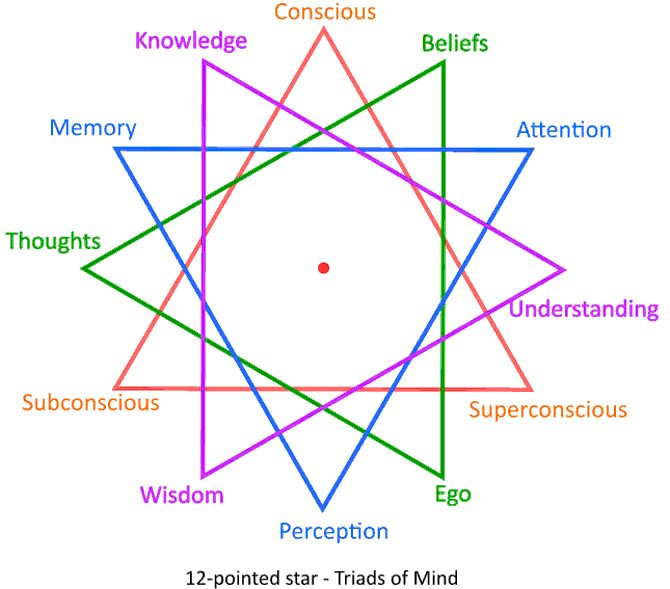
The 12/3 12-pointed star, made up of four interlocked triangles, symbolizes the diverse aspects of the human mind:
- Conscious, Subconscious, Superconscious: These three points represent different states of our awareness.
- Knowledge, Understanding, and Wisdom: These signify the three aspects of learning and intellectual growth.
- Memory, Attention, and Perception: These highlight the three main cognitive functions that shape our experience of the world.
- Thought, Beliefs, Ego: These underscore the psychological elements that shape our self-identity and worldview.
9. 4 Triads of Existence
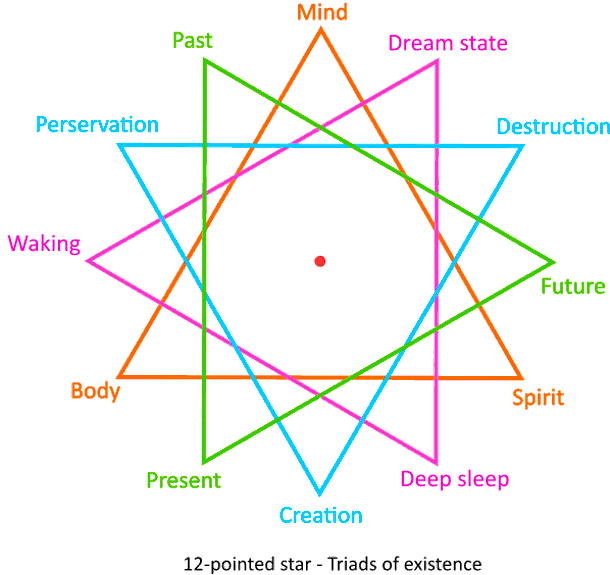
The 12/4 12-pointed star symbolizes various important and interconnected triads of existence as follows:
- Mind, Body, Spirit: This triad represents the mental, physical, and inner essence of a human being.
- Past, Present, Future: These are three interconnected aspects of time that define our reality.
- Creation, Preservation, Destruction: This triad represents the cycle of life where there is creation, preservation, or sustenance of what has been created, and then the destruction of the old to make way for the new.
- Waking, Dreaming, Deep Sleep: These are our three states of existence. The waking or conscious state, the dream state where the mind is engaged in dreams, and the state of deep sleep where you become one with the cosmos.
Each point of the star thereby encapsulates a unique aspect of life and existence.
10. 4 Triads of Matter
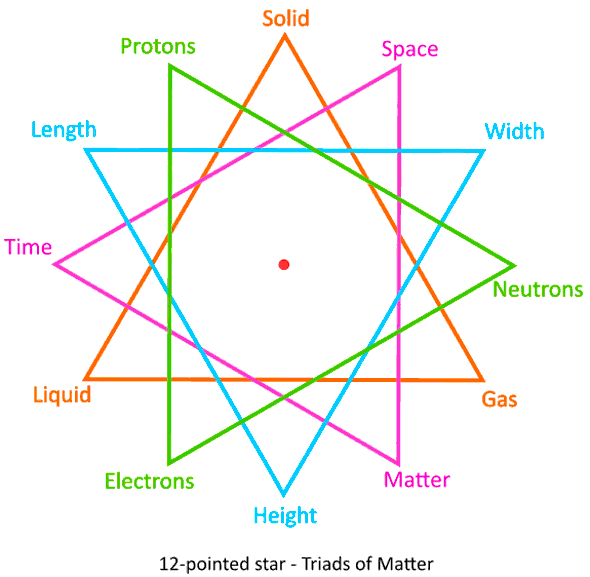
The 12/4 12-pointed star can be used to symbolize the important triads of matter in the material universe.
- Solid, Liquid, Gas: These signify the three fundamental states of matter.
- Protons, Electrons, Neutrons: These are the three particles that constitute an atom (the smallest part of matter), representing positive, negative, and neutral energies.
- Time, Space, Matter: These are the essential components of the physical universe.
- Length, Width, Height: These dimensions define the size and shape of objects in the physical world.
11. Sun and Solar Energy
In Hinduism, the Sun god Surya has 12 forms each related to a month of the year. Names of these forms and what they signify are as follows:
- Mitra: The friend of all.
- Ravi: The shining or the radiant one.
- Surya: The supreme light.
- Bhanu: The bright one.
- Khaga: The one who moves through the sky.
- Pushan: The nourisher of life.
- Hiranyagarbha: The originator or source of everything.
- Marichi: Ray of light.
- Aditya: Son of Aditi, the infinite mother.
- Savitra: The stimulator or the vivifier.
- Arka: The radiant or the brilliant one.
- Bhaskara: The giver of enlightenment.
Also, in most ancient cultures the solar cycle lasts for exactly 12 months. So in essence, the 12-point star could be seen as a representation of the sun’s eternal energy, and illumination.
12. 12-Pointed Star and Seed of Life – Creative Energy & Interconnectedness
The Seed of Life is one of the most important sacred geometry symbols that represents the seven stages of creation and the interconnectedness of all life across the universe.
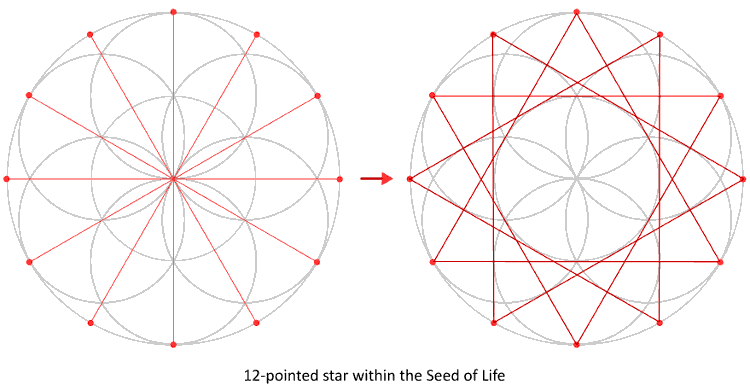
Similar to the 6-pointed star, the 12-pointed star is also embedded within the Seed of Life. As depicted in the image below, twelve straight lines drawn from the center passing through the circle’s intersection points create twelve points on the boundary. Linking these twelve points, we can form all four types of the 12-pointed star.
Therefore, the 12-pointed star embodies everything the Seed of Life signifies, such as creation, unity, balance, and the interconnectedness of all life.
Conclusion
In addition to what has been discussed, the 12-pointed star can also be used to represent the 12 gods of Olympus, 12 tribes of Israel, and the 12 Apostles of Jesus.
While you might be more familiar with the six-pointed star, the 12-pointed star is equally rich in deep symbolism and profound meanings. Its lesser-known status does not diminish its power.
In fact, it may hold a unique appeal to you if you connect with the meaning it encapsulates. Its powerful symbolism can provide you with insights, guidance, inspiration, and a sense of connection to the broader universe.
Therefore, if its diverse meanings resonate with you, the 12-pointed star can become a significant tool on your spiritual journey.




